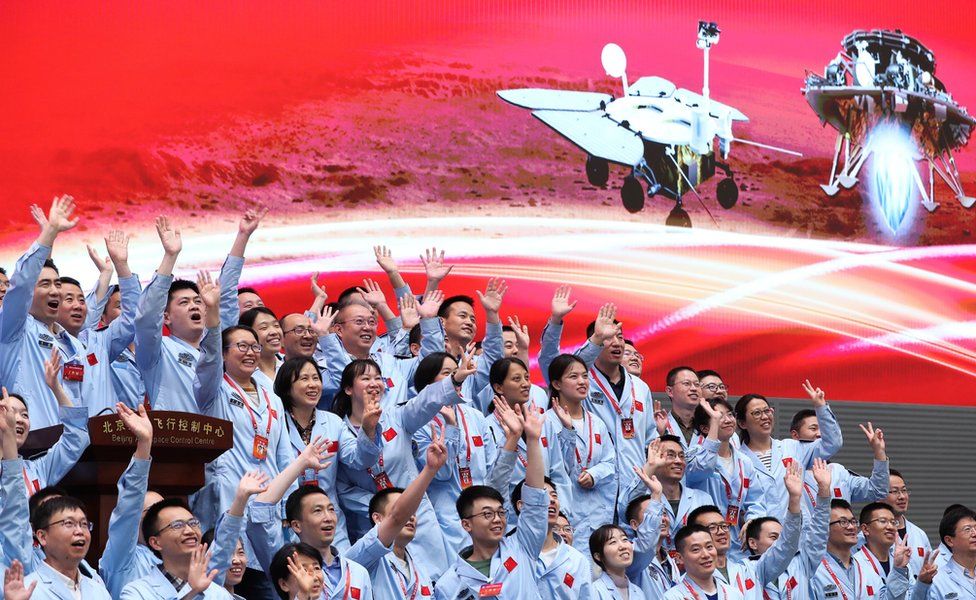
China has successfully landed a spacecraft on Mars, state media announced early on Saturday.
The six-wheeled Zhurong robot was focusing on Utopia Planitia, a huge landscape in the planet’s northern half of the globe. The vehicle utilized a mix of a defensive case, a parachute and a rocket stage to make the plummet. The effective score is an exceptional accomplishment, given the troublesome idea of the undertaking. Just the Americans have truly dominated arriving on Mars up to this point. Any remaining nations that have attempted have either slammed or lost contact not long after arriving at the surface. Chinese President Xi Jinping praised the mission group on its “remarkable accomplishment” in an exceptional message.”You were courageous enough for the test, sought after greatness and put our country in the high level positions of planetary investigation,” he said. Thomas Zurbuchen, the head of science at the US space organization (Nasa), was fast additionally to add his own congrats. “Along with the worldwide science local area, I anticipate the significant commitments this mission will make to mankind’s comprehension of the Red Planet,” he said.The robot formally arrived at 07:18 on Saturday, Beijing time (Friday 23:18 GMT), as indicated by state media. It required 17 minutes to unfurl its sun based boards and convey a message back to Earth. Zhurong, which implies God of Fire, was conveyed to Mars on the Tianwen-1 orbiter, which showed up over the planet in February. The test at that point invested energy reviewing Utopia, taking high-goal pictures to pinpoint the most secure spot to put the meanderer down. The point with all such endeavors is to pick a recognize that is without forcing pits and where the scene isn’t shrouded in enormous stones.Chinese specialists would have needed to follow the arrival exertion with a delay. The current distance to Mars is 320 million km, which means radio messages require just about 18 minutes to arrive at Earth. Each phase of the Zhurong robot’s way to deal with the surface accordingly would have been directed self-sufficiently. The arrival design was a recognizable one. The wanderer was encased in an aeroshell for the underlying period of the nine-minute plummet. This present container’s plunge to the surface was eased back by pushing toward the Martian air. The warmth this created was overseen by a front oriented safeguard. At a foreordained time, a parachute opened to lessen the speed even further. At long last, the Zhurong robot split away on a rocket-fueled seat for the moves that took it securely to the ground. Arriving on Mars is consistently an overwhelming test however China would have had certainty going into the technique, given the incredible fitness it has appeared in its space attempts of late. This is a country that has been putting meanderers on the Moon, and taking lunar examples back to Earth. This month it dispatched the main section of a space station over our planet. Since Zhurong has down effectively, researchers will attempt to receive in any event 90 Martian long stretches of administration in return, contemplating the nearby geography. A day, or Sol, on Mars keeps going 24 hours and 39 minutes. The robot looks a great deal like Nasa’s Spirit and Opportunity vehicles from the 2000s. It gauges some 240kg and is controlled by crease out sun powered boards. A tall pole conveys cameras to take pictures and help route; five extra instruments will examine the mineralogy of neighborhood rocks and the overall idea of the climate, including the climate. Like the American wanderers, Zhurong has a laser instrument to destroy rocks to survey their science and a radar to search for sub-surface water-ice. Perfect world Planitia is the place where Nasa handled its Viking-2 mission in 1976. It’s a goliath bowl – more than 3,000km across – that was shaped by an effect from the get-go in Mars’ set of experiences. There is some proof highlighting it having held a sea quite a while in the past. Distant detecting by satellites shows there are critical stores of ice at profundity.





































































































































































































































































































































































































































































































































































































































































































































RSS